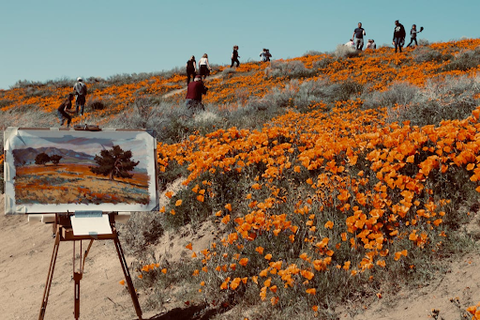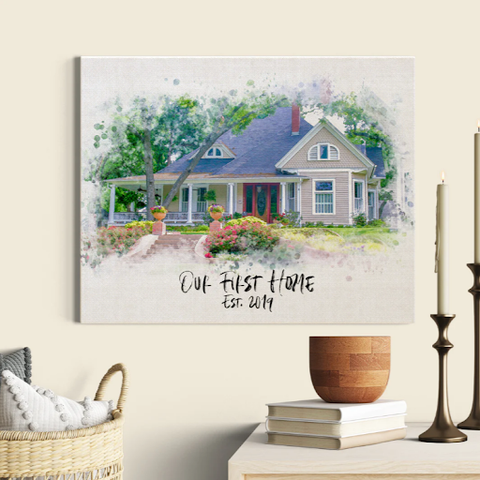Embark on a captivating journey through the fascinating realm of landscape art history, where we'll unravel its evolution and delve into its profound impact on the world of art. Tracing its roots from ancient civilizations to modern-day interpretations, landscape art has consistently enthralled artists and viewers, giving rise to many masterpieces that magnificently exhibit the breathtaking beauty and intricate complexity of the natural world.
Definition of Landscape Art
Landscape art depicts natural scenery in artistic works, typically capturing elements such as mountains, forests, rivers, and other geographical features. This genre aims to evoke emotions, create a sense of place, and highlight the relationship between humans and nature. Landscape art can be found in various forms, including canvas paintings, drawings, photographs, and digital art.
The Evolution of Landscape Art
Early Landscape Art
The origins of landscape art, can be traced back to ancient civilizations, with examples found in Egyptian tomb paintings and frescoes from ancient Rome and Greece. These early depictions often served as backgrounds for religious or historical narratives, with landscape elements playing a secondary role in the composition.
The Emergence of Landscape as a Genre
Landscape art began to gain prominence as an independent genre during the Renaissance, as artists focused more on the natural world and its beauty. The development of linear perspective and the increased emphasis on realism in art further contributed to the rise of landscape painting.
In the 17th century, Dutch and Flemish artists, such as Jacob van Ruisdael and Peter Paul Rubens, pioneered the landscape genre, producing works that captured the distinct characteristics of their native lands.
Modern Landscape Art
The 19th century saw a significant shift in landscape art history with the emergence of landscape painting and modern movements like Romanticism, Impressionism, and Post-Impressionism. Artists like J.M.W. Turner, Claude Monet, and Vincent van Gogh redefined the genre by experimenting with color, light, and brushstrokes to create evocative and emotional representations of nature.
Contemporary Landscape Art
In contemporary art, landscape artists continue to push the boundaries of the genre by incorporating new media, techniques, and conceptual approaches. Environmental concerns, urbanization, and cultural identity have emerged as prominent themes in modern landscape art, reflecting the evolving relationship between humans and nature.
Famous Landscape Artists and their Works
Leonardo da Vinci: "The Virgin of the Rocks"
One of the most renowned artists in history, Leonardo da Vinci, created "The Virgin of the Rocks" in the late 15th century. Although not primarily a landscape painting, the work features a captivating background of rocky formations and lush vegetation, showcasing da Vinci's ability to skillfully integrate landscape elements into his compositions. This masterpiece demonstrates his keen eye for detail and his mastery of atmosphere.
John Constable: "The Hay Wain"
English Romantic painter John Constable is celebrated for his evocative landscape paintings, with "The Hay Wain" one of his most iconic works. Painted in 1821, this scene depicts a horse-drawn cart in a serene countryside setting, capturing the beauty and tranquility of rural England. Constable's dedication to naturalism and his distinctive brushwork contribute to the enduring appeal of this masterpiece.
Thomas Cole: "The Oxbow"
American artist Thomas Cole is known as the founder of the Hudson River School, an art movement characterized by its focus on the American landscape. "The Oxbow," painted in 1836, is a prime example of Cole's work, featuring a sweeping view of the Connecticut River Valley. The painting contrasts untamed wilderness with cultivated farmland, symbolizing the tension between nature and civilization.
J.M.W. Turner: "The Fighting Temeraire"
J.M.W. Turner, a prominent English Romantic painter, is revered for his ability to convey intense emotions through his landscape art. "The Fighting Temeraire," completed in 1839, showcases Turner's masterful handling of light and color as he portrays the dramatic sunset behind the decommissioned warship. The work conveys a sense of nostalgia and the passage of time, reflecting on the changing world during the Industrial Revolution.
Claude Monet: "Water Lilies" series
French Impressionist painter Claude Monet is renowned for his "Water Lilies" series, a collection of approximately 250 paintings created between 1899 and 1926. Inspired by the lily pond in Monet's garden at Giverny, these works are characterized by their loose brushstrokes, luminous colors, and emphasis on the fleeting effects of light and atmosphere. Monet's innovative approach to landscape painting has had a lasting impact on the art world.
Vincent van Gogh: "The Starry Night"
Dutch Post-Impressionist painter Vincent van Gogh is celebrated for his vibrant, expressive landscape paintings. "The Starry Night," completed in 1889, is one of his most famous works, featuring a swirling night sky over the small village of Saint-Rémy-de-Provence. The painting's dramatic brushstrokes and vivid colors convey a sense of energy and emotion, making it a powerful and enduring representation of the natural world.
Significance of Landscape Art in Contemporary Art
In contemporary art, landscape art is vital, inspiring artists to explore new perspectives on the natural world. From traditional canvas painting to innovative digital works, landscape art challenges artists to capture the essence of nature while addressing pressing environmental and social issues. The genre also encourages experimentation with various mediums, such as acrylic portrait painting, photography, and mixed media.
Final Thoughts
From its humble beginnings as a backdrop for narratives to its current status as a powerful and versatile artistic genre, landscape art has proven its ability to transcend time and cultural boundaries. The journey through landscape art history reveals artists' enduring fascination with the natural world and its ever-changing beauty. As the genre continues to evolve, landscape art will remain a significant and captivating form of creative expression, inspiring artists and viewers alike to reflect on our connection to the environment and the planet we inhabit.
By appreciating and understanding the history of landscape art, we can better grasp the significance of this genre in contemporary art and its potential for future growth. Landscape art not only showcases the beauty and complexity of the natural world but also serves as a reminder of our responsibility to protect and preserve our environment for future generations.
Order Your Creative and Charming Landscape Art at Memorialize Art
Are you inspired by the rich history of landscape art and eager to own a piece that captures the essence of nature's beauty? At Memorialize Art, our team of skilled artists is dedicated to creating stunning landscape artworks that reflect your unique vision and style. Whether you're looking for a house portrait that immortalizes your beloved home or a mesmerizing landscape painting that transports you to a serene, natural setting, we have you covered.
Take advantage of the opportunity to own a one-of-a-kind landscape artwork that will be treasured for years. Visit our website today and order your creative and charming landscape art at Memorialize Art.














